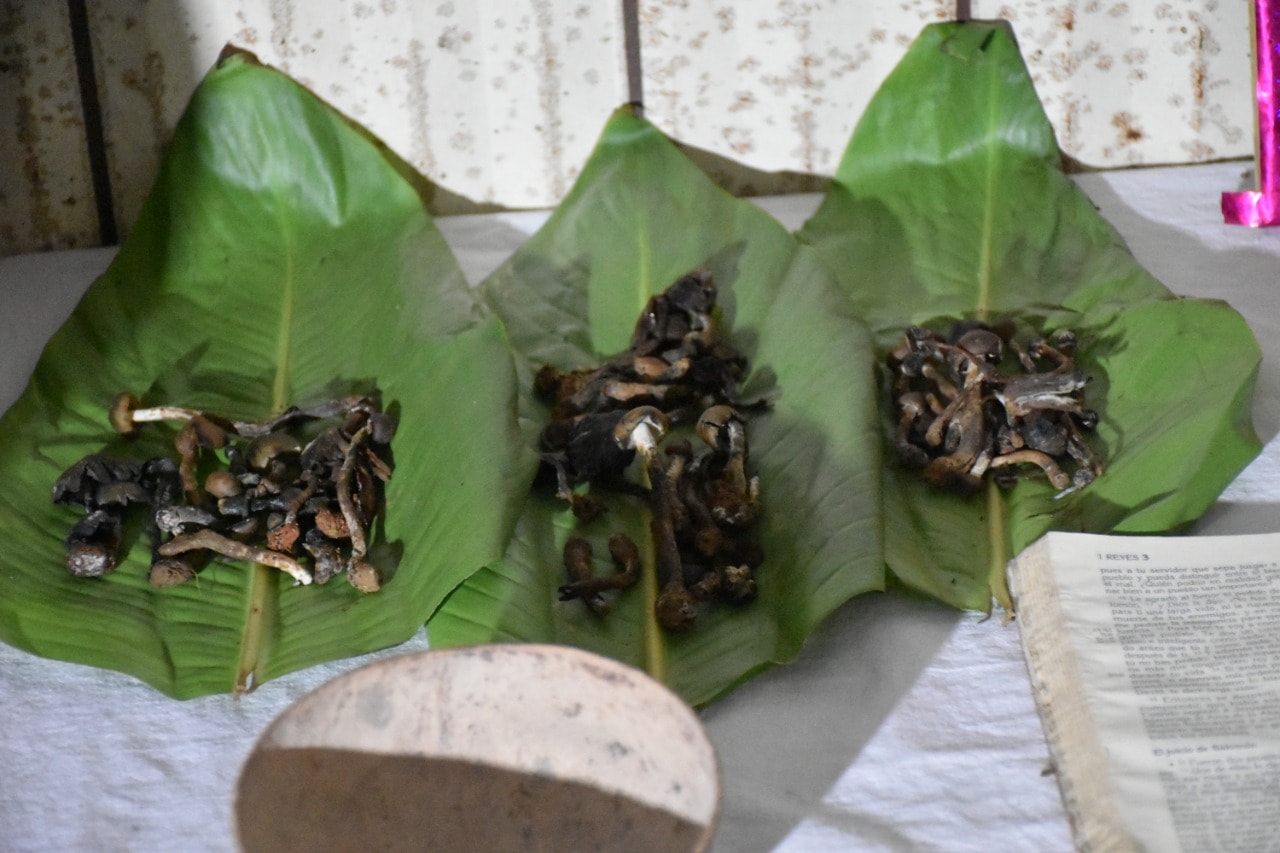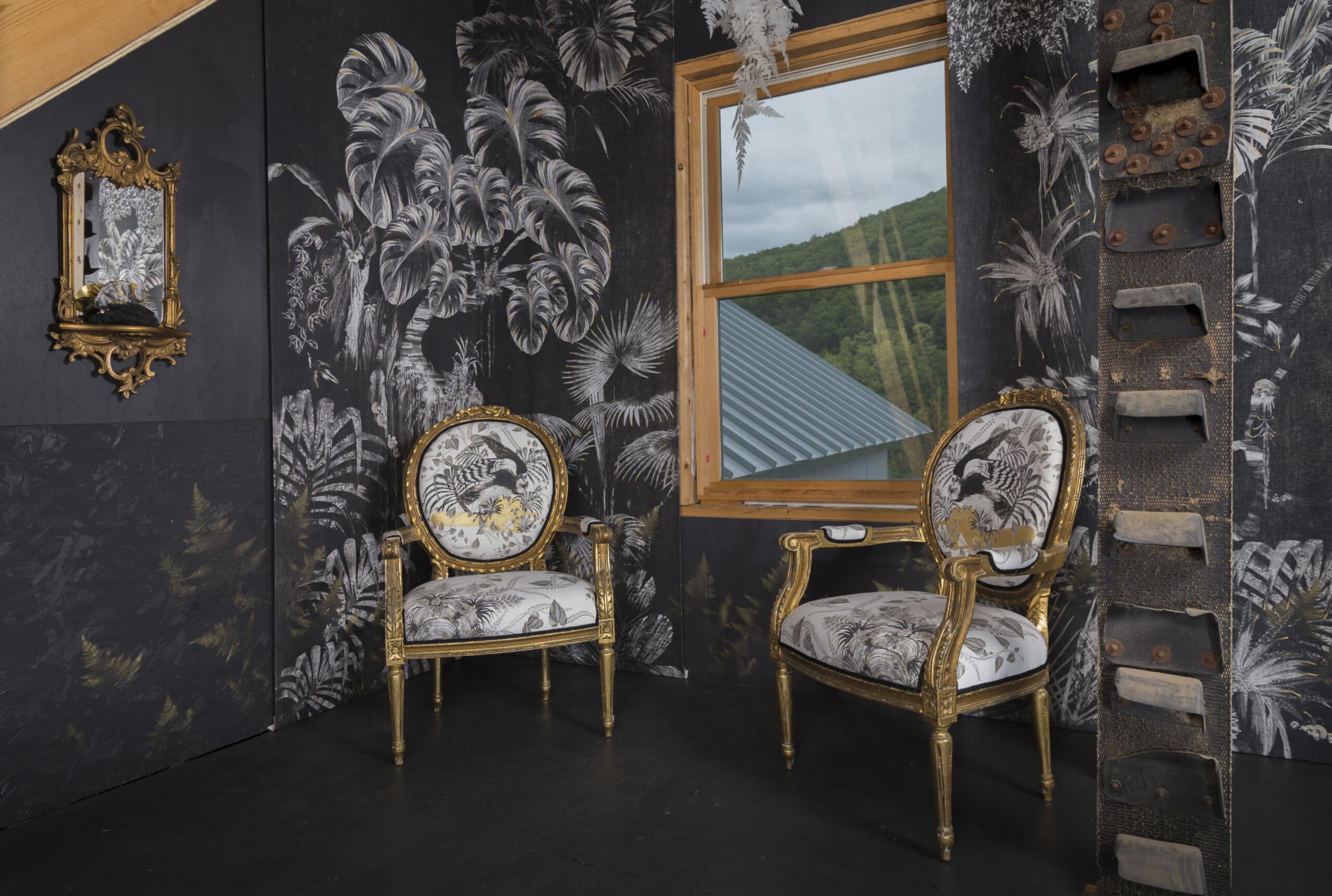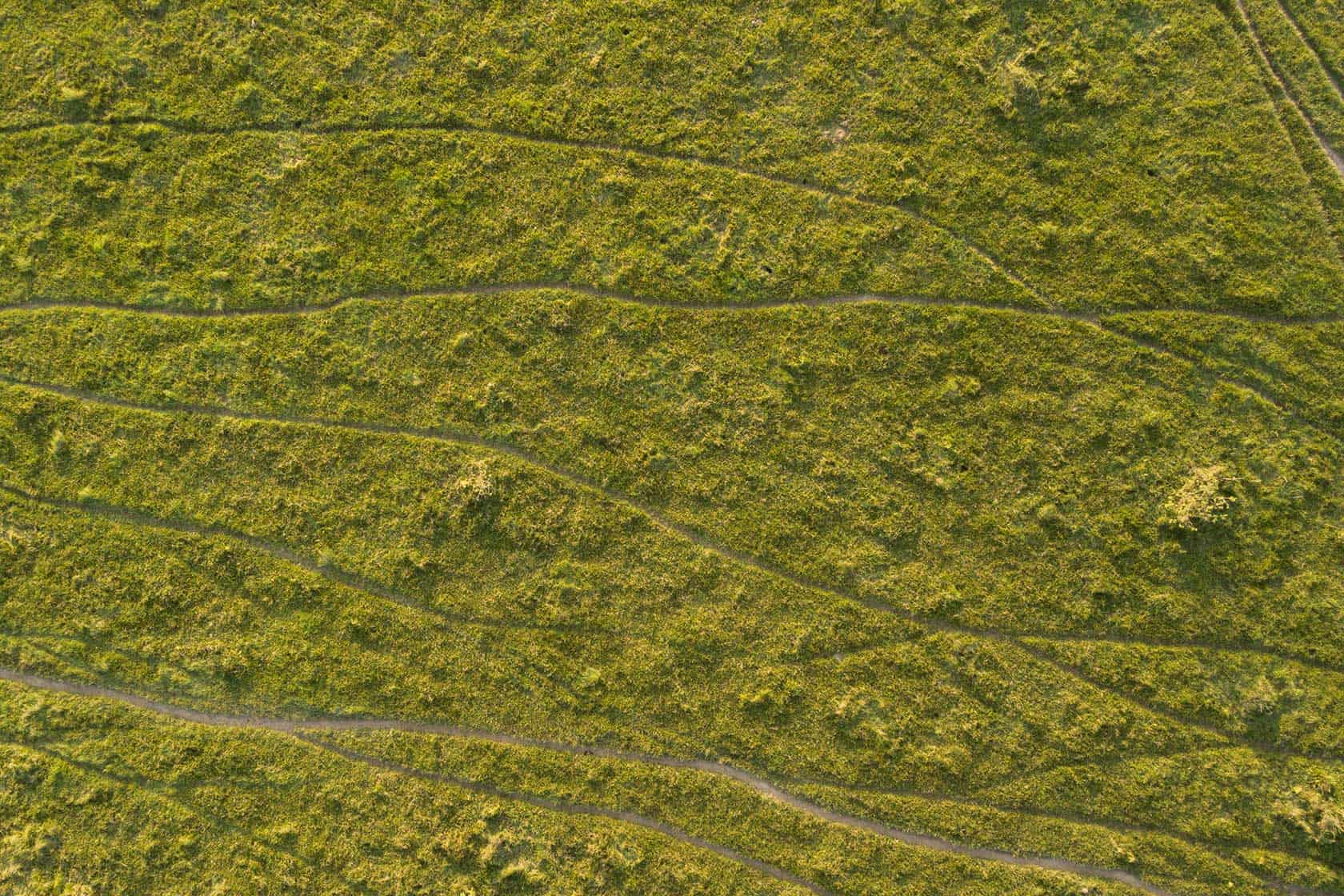
Hopefully the Night will Never Come
In one of the images, a huge river meanders cross through a forest. In another there is a yellowish green field crossed by brown lines. They are the access roads to the Guayabero region, a protected area of the Colombian Amazon that occupies part of the territory of three departments. Among the jungle there are increasingly large patches of deforested areas planted with coca crops, most of them with pasture for livestock.
Photographer Andrés Cardona and reporter Lise Josefsen Hermann entered this environmental protection zone to tell stories of women who have some relationship with coca leaf crops.
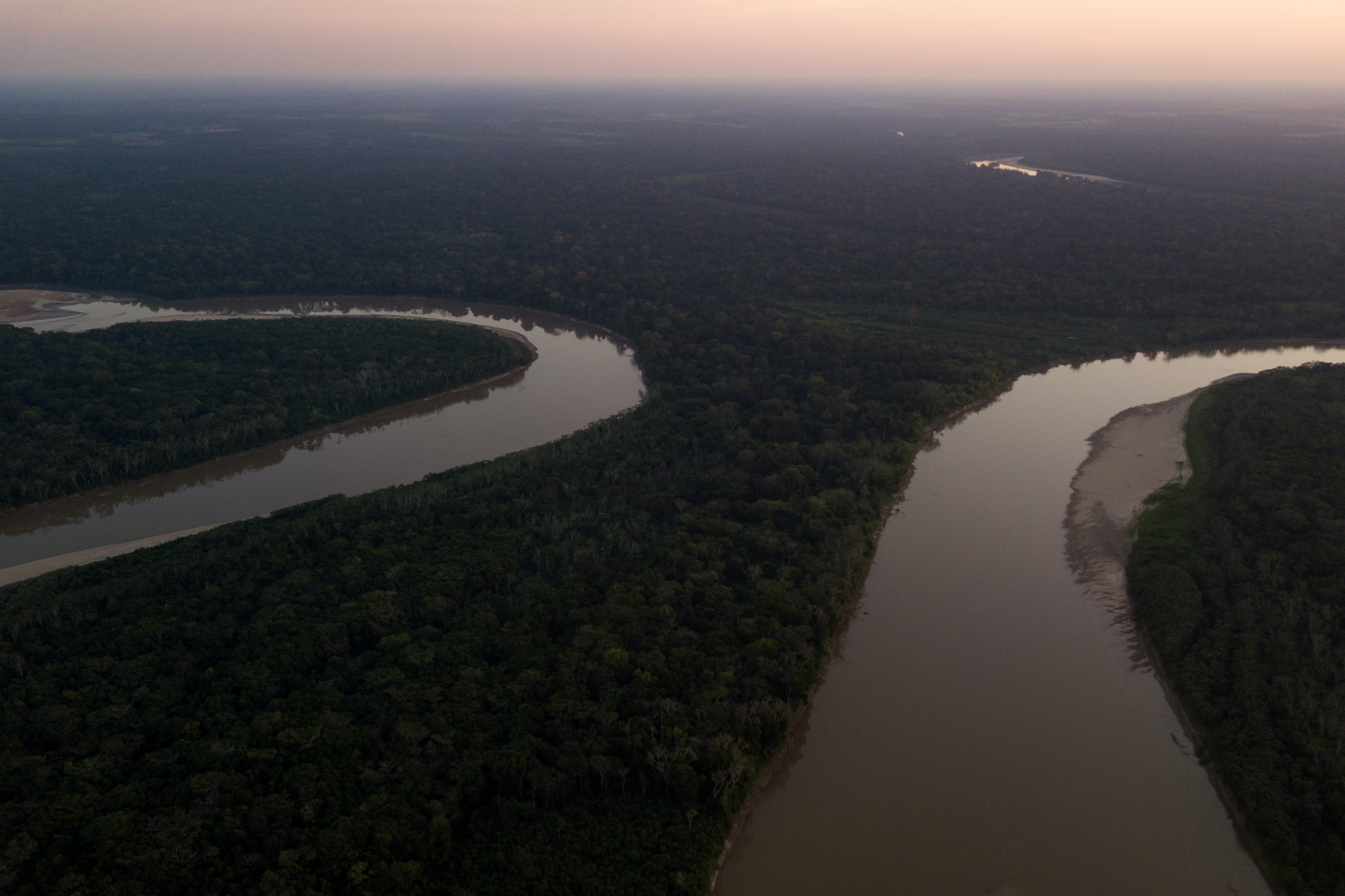
Sunset on the Guayabero river. By Andrés Cardona
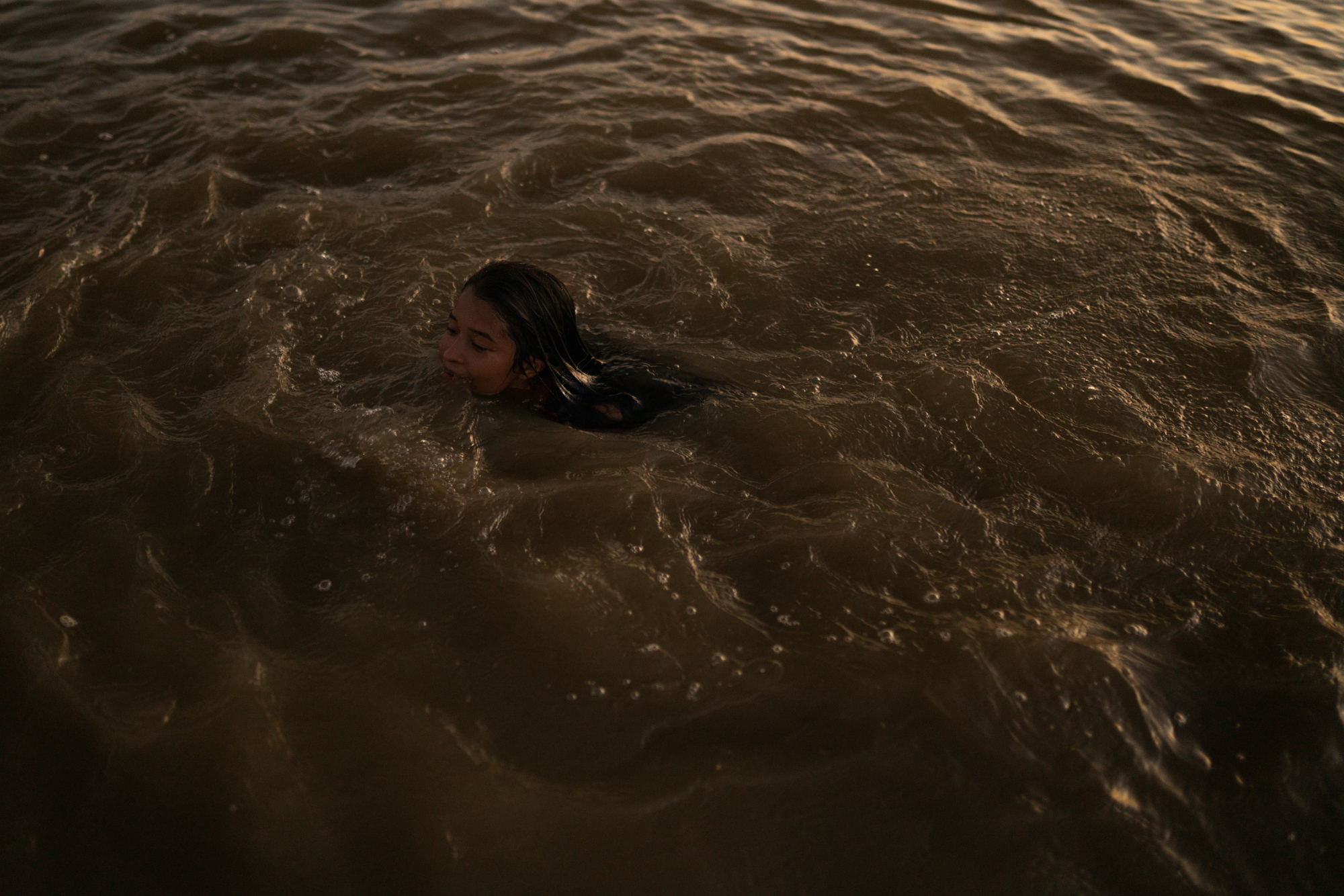
Yesica Yulieth López Ávila is 15 years old. She swimss in the Guayabero river. By Andrés Cardona.
Some have small fields with which they get money to buy food or send their children to school. Others have been affected by the forced eradication plans of the Colombian state, or have stories close to the defunct FARC guerrilla. They all share something: “the fear of what it means to be on a farm in the middle of a natural park where there is military repression and where the military has done so many excesses and human rights violations,” Andrés says. The fear of being alone in such a place.
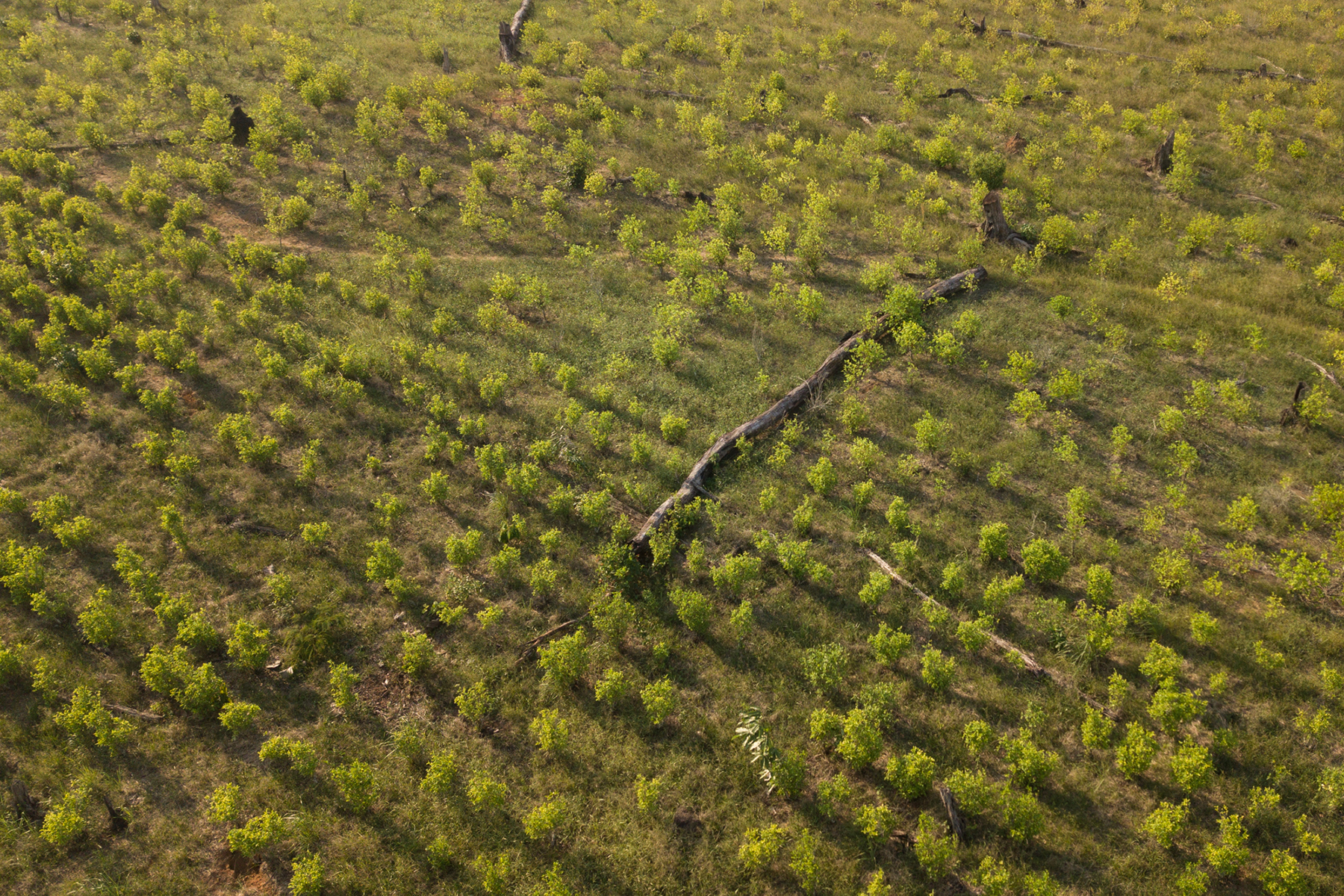
Coca cultivation in the Caño San José village, in the middle of the Serranía de la Macarena National Park. By Andrés Cardona.
For a long time the region was the territory of the FARC, which built some roads and served as an authority. After the signing of the La Habana Peace Process, in a short time dissidents of that armed group were reorganized, and on the part of the state, processes were initiated for the military recapture of the natural park areas. Deforestation intensified and with it came big amounts of cattle. Coca was already there and for many it continued to be a source of income.
The report that Andrés and Lise did collects stories of women who have important stories to tell: because they have been witnesses, because they have been victims, because they are leaders in that area of Colombia. But it also raises an important issue: in regions with weakened economies, coca is an alternative to survive. And not only that, in these jungles the base paste, which will later be crystallized and converted into cocaine, is the bargaining chip for buying and selling things.
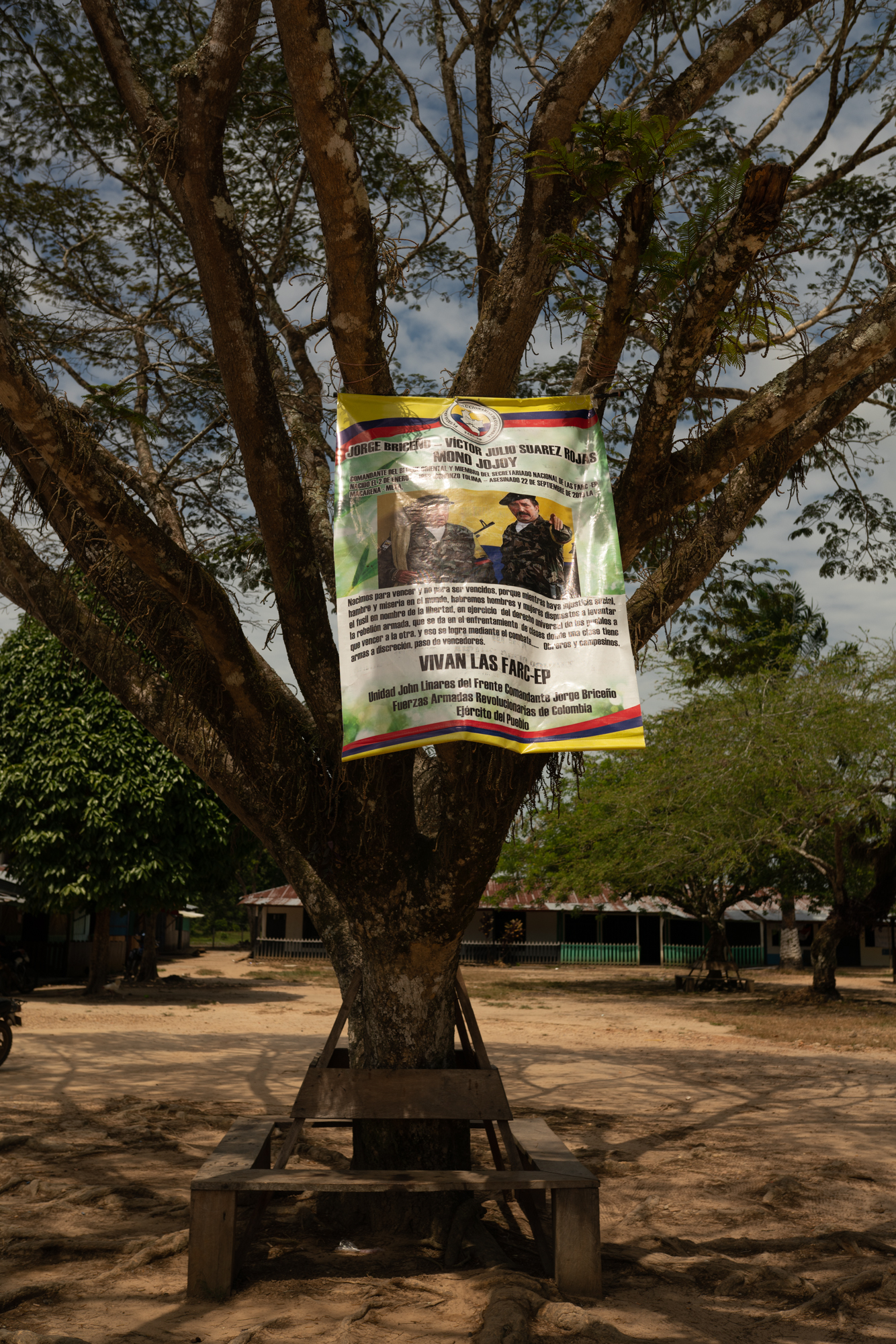
A banner alluding to the assassinated commander Jorge Briceño alias el Mono Jojoy of the guerrilla of the former FARC, this is in the middle of the town of Nueva Colombia in the Guayabero region. By Andrés Cardona.
How is ‘Hopefully the night will never come’ constructed?
The report is divided into two parts. The first has to do with the worldview of women in a territory where many things converge. One of them is that these people are settled in a national natural park, that is, in a protected area. Second, for us it was very important to narrate the drug issue from the perspective of women.
When we proposed this work with Lise Josefsen Hermann, we always thought that the narrative of drugs has had a very masculine vision, very masculine. We think that perhaps if we talk about the role of women in these coca-growing areas, a different perspective could be given to what the production of coca paste means in a country like Colombia, where, for example, and as a third important point, It is about people who live in a natural park and have problems because of that.
So the first part of the project has to do with that. What do women dream of, what do women envision in a territory like this and with Lise we came to the conclusion that generally their dreams are simple ones: food, education, health, safety, having peace of mind, having a road to have take out their products and about all state investment. Because as it is an area of coca base production, that is the economy.
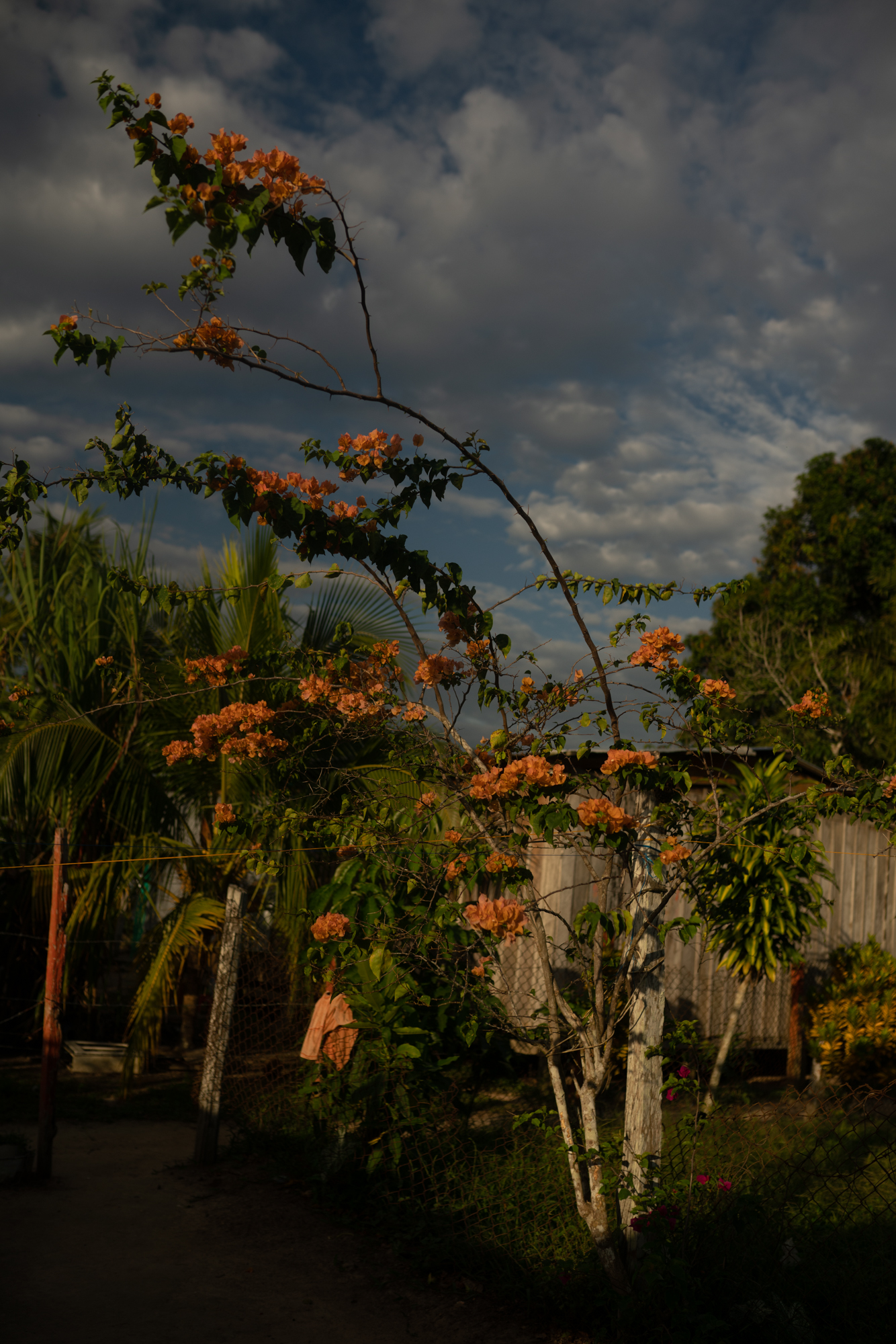
Gardens in Nueva Colombia. By Andrés Cardona.
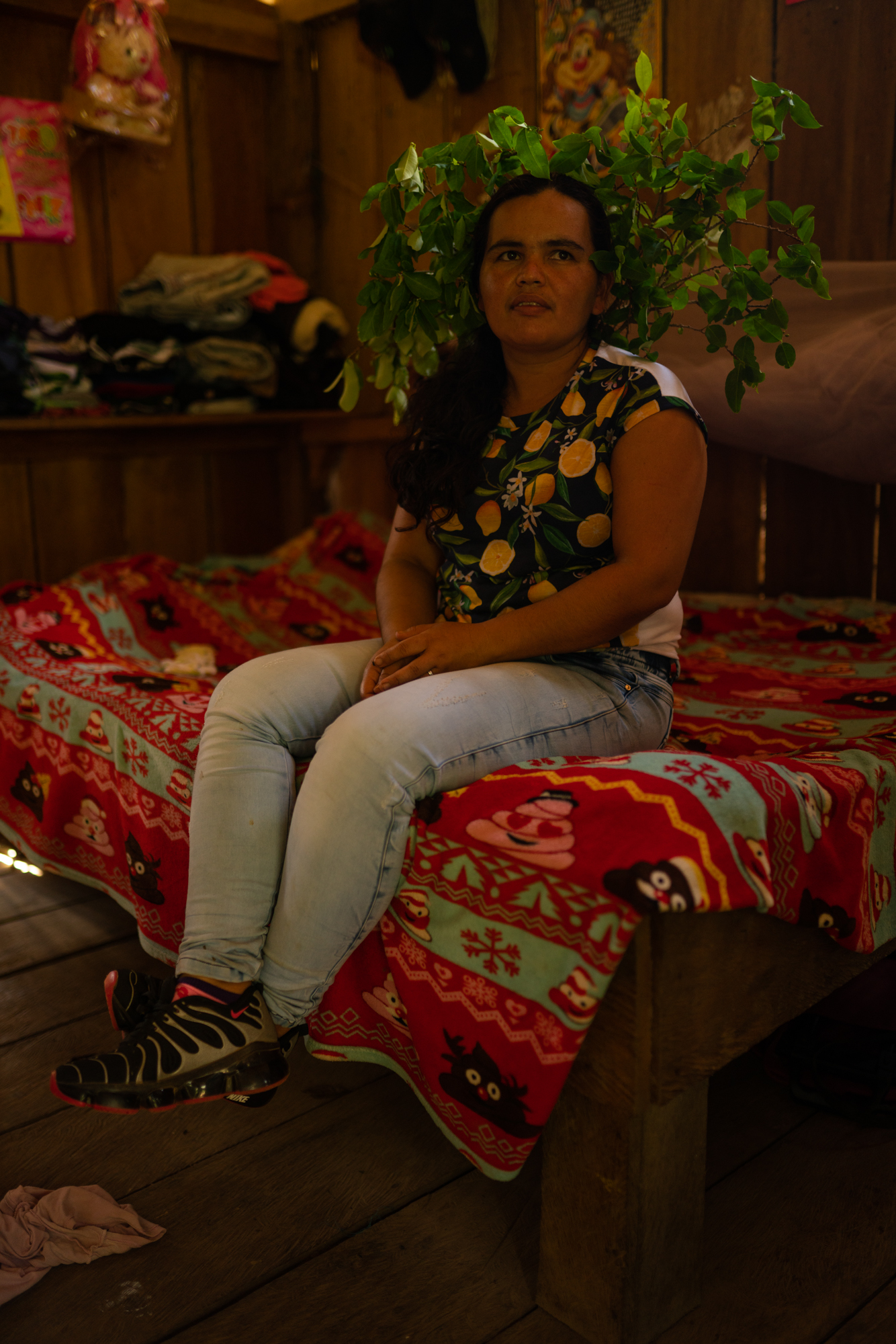
Leonilde Hernández Rincón is 30 years old and she is a leader of the Caño Cabra town, she has 3 kids and was born in the Guayabero region. By Andrés Cardona.
From that we created a series that is like an arm of the report, it is called Coca Coin Colombia. When we arrived there we began to see that people sent their children to the store with grams of coca paste, they told them go and bring a pound of tomatoes or bring me an onion, in short, everything, a beer, sausages, everything paid with coca paste.
This let us show that the economy of this region in particular is not very strong. In the first place, the Colombian peso, that is, the paper is lost because being an area of such risk that also has the presence of illegal groups and FARC dissidents, it is difficult for buyers of the cocaine paste to enter. So people use it this as a bargaining chip.
Knowing that these people are in danger, we decided not to show people’s faces by buying things with base paste. Also because the State forces use this type of report as probative material. So we decided to do something a little more symbolic: we put together a small set with a black background and began to put basic products next to the amount that must be had in grams of coca base to buy a beer, to buy a toy for a child, a cap, or a radio.
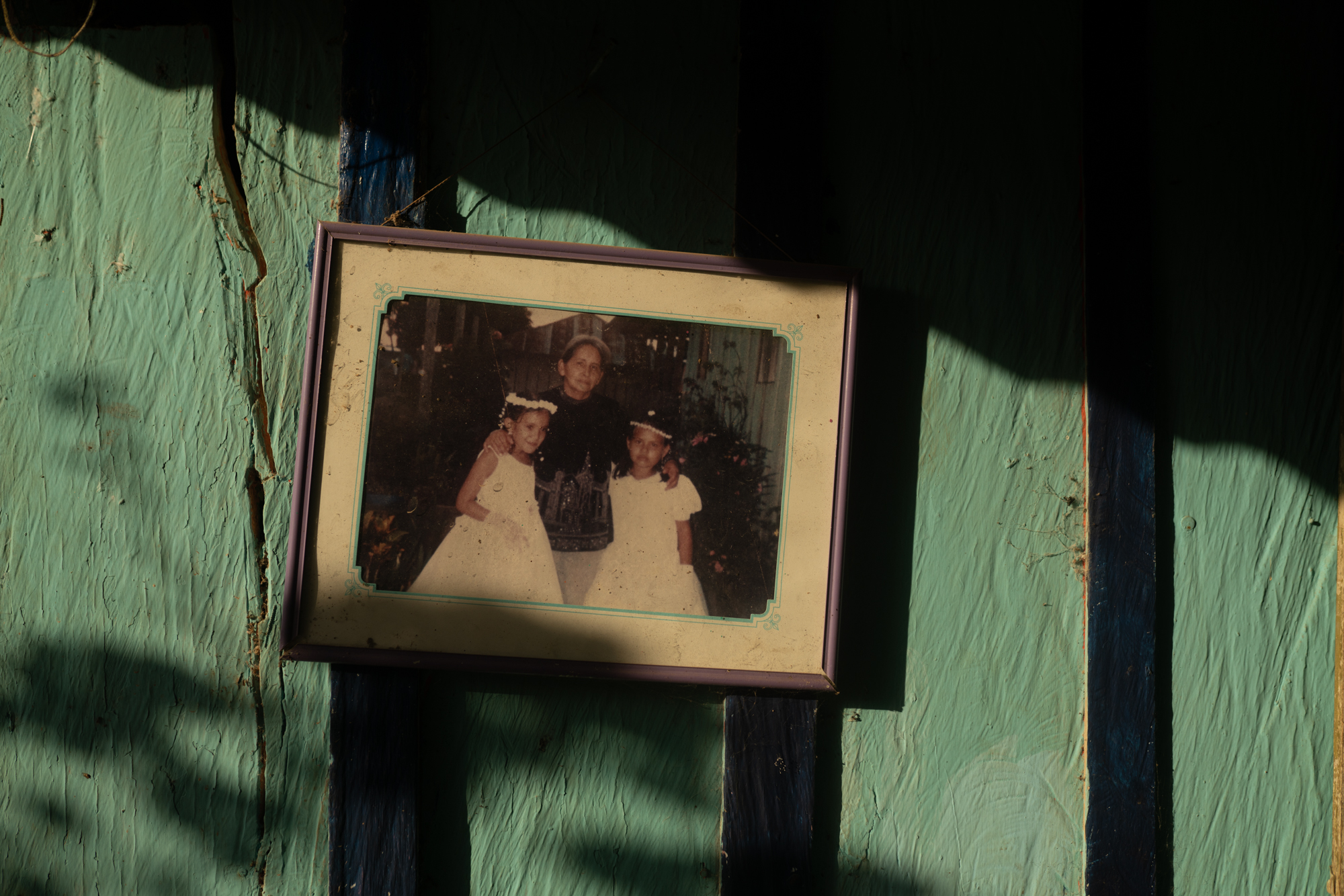
Portrait of a first communion in the Nueva Colombia town. By Andrés Cardona.
Can you talk a little more about the region?
This place is very particular, it is a territory called El Guayabero, where converges three departments that also happen to have protected areas. There is a problem, first, because due to the context of spatial distribution and especially the area where they are, there is a total abandonment of the State. They are remote areas on the edge of the jungle and there is a total abandonment. What the State has done in territories like these where hundreds of families live has simply started to veto their inhabitants. You cannot build roads and schools have been built by the community.
A few years ago, there was a court ruling that ordered the State that in some way these territories will be retaken, since they are areas of protection. The State began to implement a military operation to retake the territories: Operation Artemisa. Instead of mediating with the people who have been in this place for 20, 30, 40 years, and where some residents did not even know that this was a natural park.
This is also the area where, recently, one of the FARC dissident camps containing minors was bombed. It is a complex area: the military forces are repressing the civilian population, coca base paste is produced and in addition to that, minors are recruited from the area who later end up being murdered by the same State that did not know how to use other tools. In addition, Colombia has a commitment to the international community with the issue of zero deforestation, this was supposed to happen by 2020. Hundreds of millions of dollars were brought to face this, a project called Vision Amazonia was created and monitoring began. This is one of the areas where the greatest deforestation has occurred.
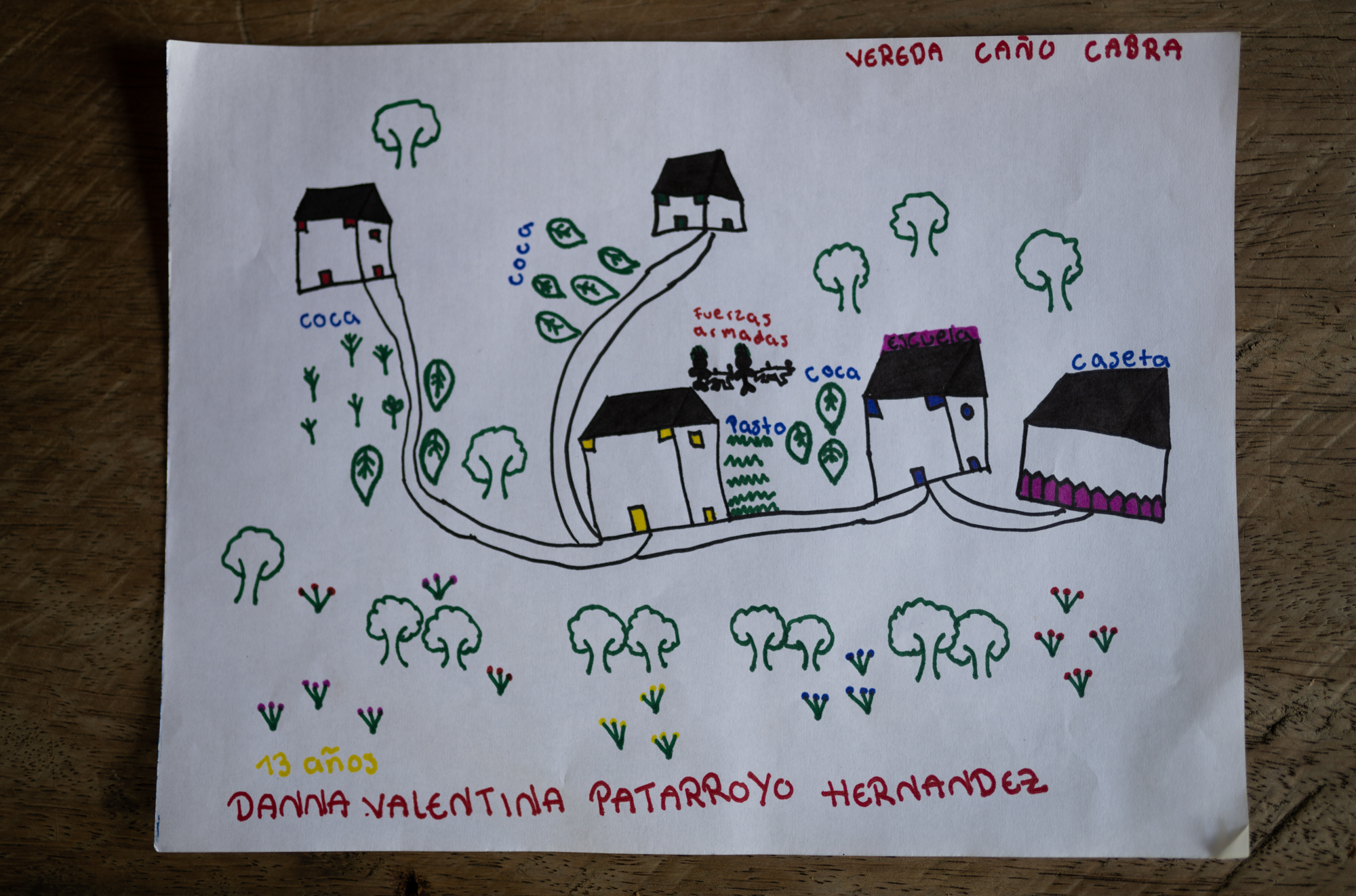
Danna Valentina Patarroyo Hernández is 13 years old and lives in the Caño Cabra village, she draws one of her memories of when she could not go to school because members of the Military Forces did not let her walk. By Andrés Cardona.
This is also the area where, recently, one of the FARC dissident camps containing minors was bombed. It is a complex area: the military forces are repressing the civilian population, coca base paste is produced and in addition to that, minors are recruited from the area who later end up being murdered by the same State that did not know how to use other tools. In addition, Colombia has a commitment to the international community with the issue of zero deforestation, this was supposed to happen by 2020. Hundreds of millions of dollars were brought to face this, a project called Vision Amazonia was created and monitoring began. This is one of the areas where the greatest deforestation has occurred.
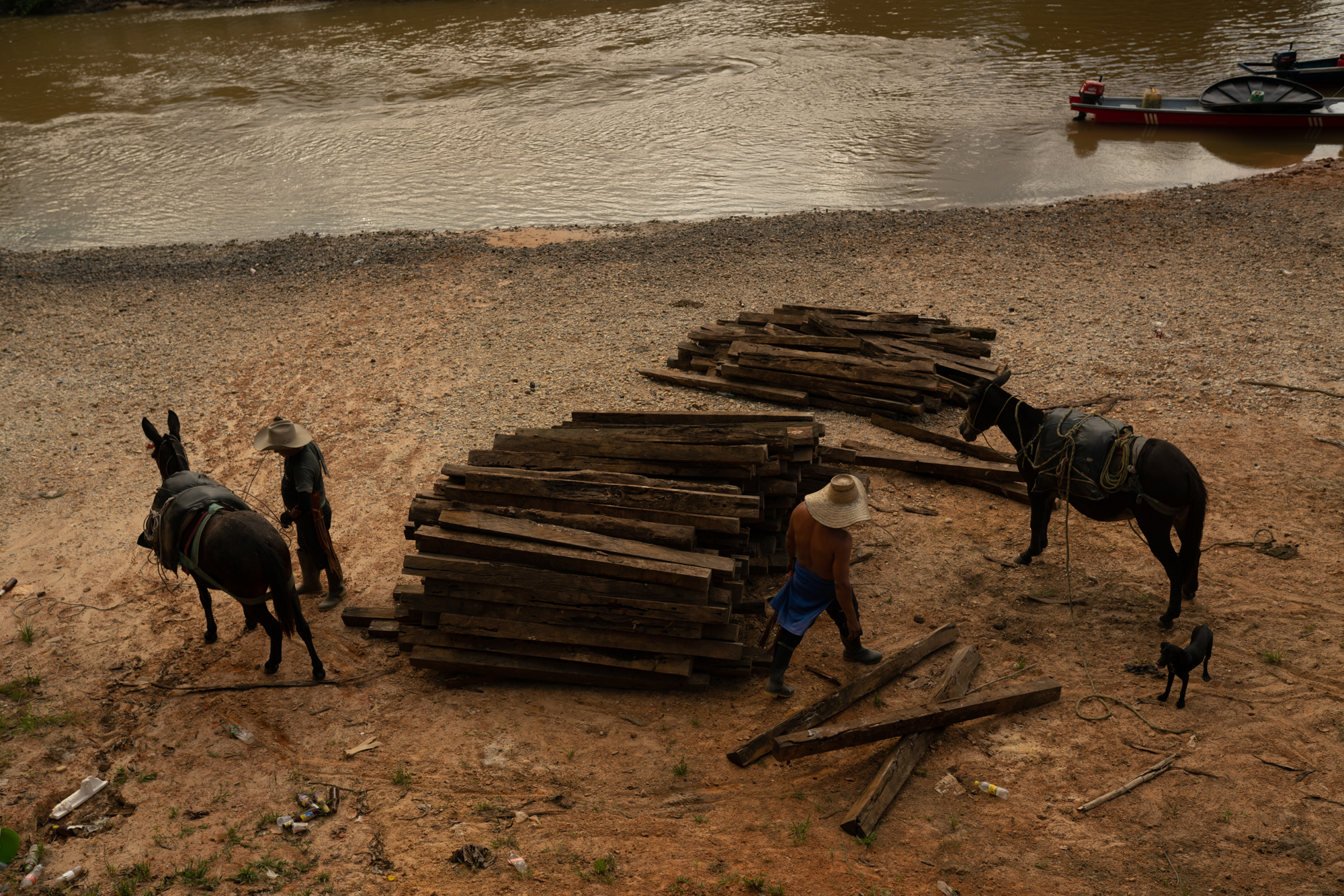
So, according to what you say, do the women who appear in the photos and in the report grow coca leaves?
Yes, they do farm, there are some that don’t. For example, there is a woman who lives with her husband and her two children, and she has coca crops and they use it for sustenance. If you see the interviews, they say “I use this to pay for my daughter’s school and to have something to eat and that’s it”. The crops are actually very small. This work also focused on women leaders, these women play an important role.
For example, in a photo of there appears a woman who is in the forest and the light shines on her, she is looking to the side. She is the president of a community action board, but she is also a journalist for the media Voces del Guayabero. Before the repression that this community is experiencing, they decided to create this media.
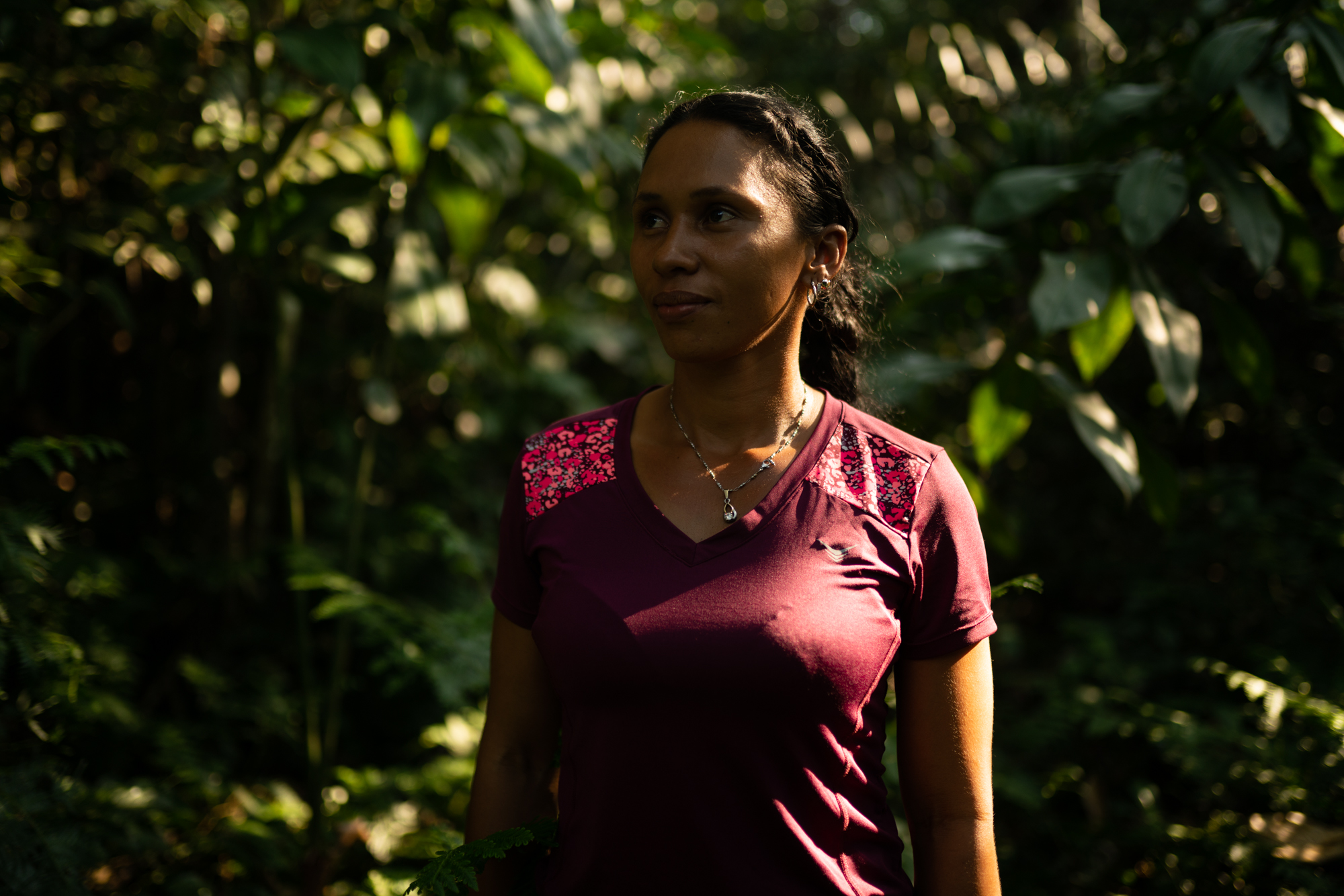
Maritza Montoya Moreno is 32 years old and a member of Voces del Guayabero, she has been systematically persecuted by members of the Military Forces of the Colombian State. By Andrés Cardona.
María is very important in the area. In this place there are no medicines, there is no doctor, there is no nurse, nor a head of infirmary, there is nothing. In other words, if someone gets sick there, they have to go to a town that is five hours away or more depending on how the road is. It’s practically an odyssey to get sick there. This woman is now one of the people who provides support on the health issue. When we were there she was taking care of a pregnant woman.
They are women who have relevant stories. Gloria’s story is very strong, the army shot to kill her cattle. Or Luz, who tells how every time they fumigated or there were confrontations, she had to get under the bed or the mattress.
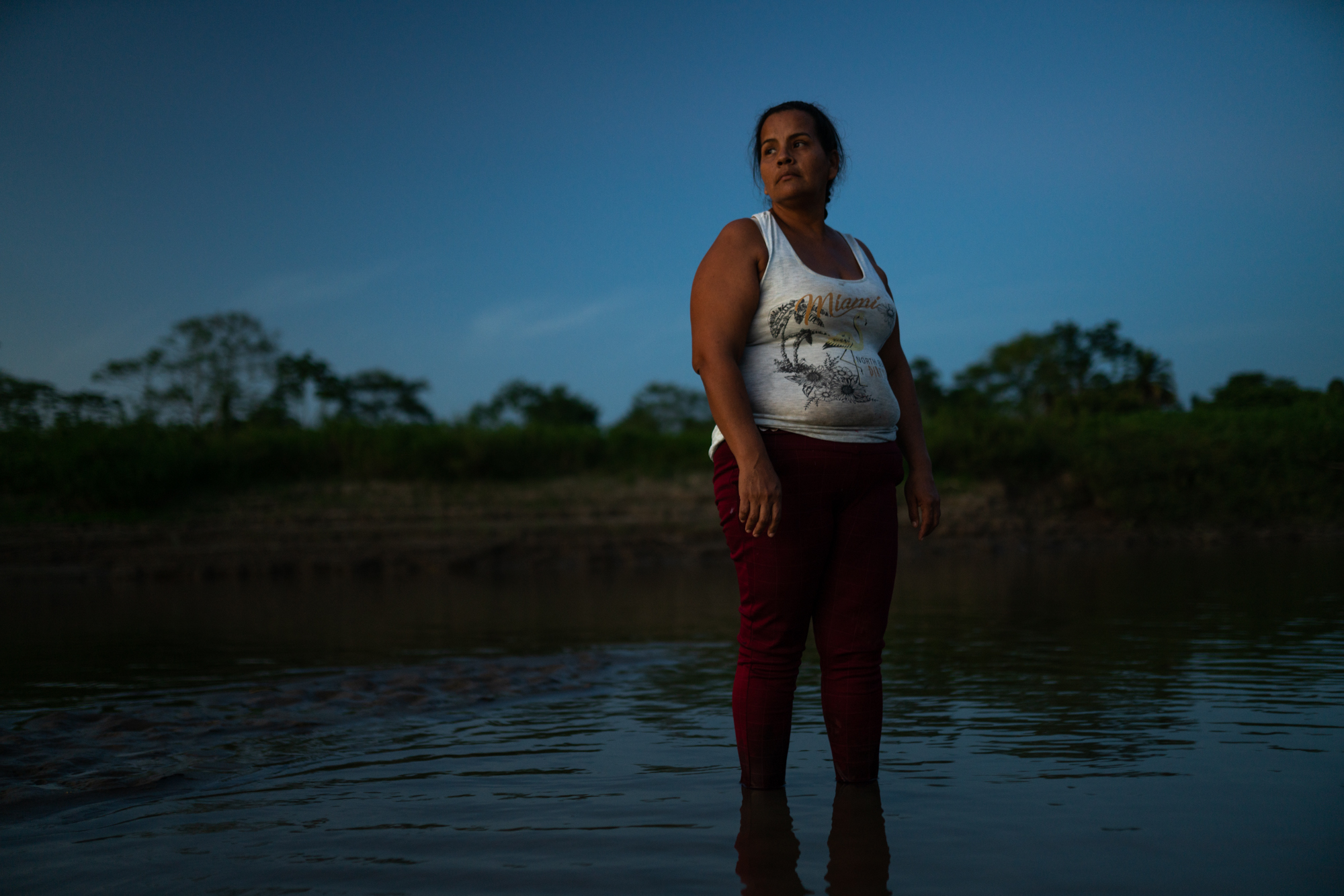
Gloria Herrera vive en la vereda Nueva Colombia y tiene 40 años de edad, integrantes del ejército mataron a 20 de sus vacas, sólo por estar en zona de parque natural, estas familias llevan más de 20 años en este territorio. Fotografía por Andrés Cardona.
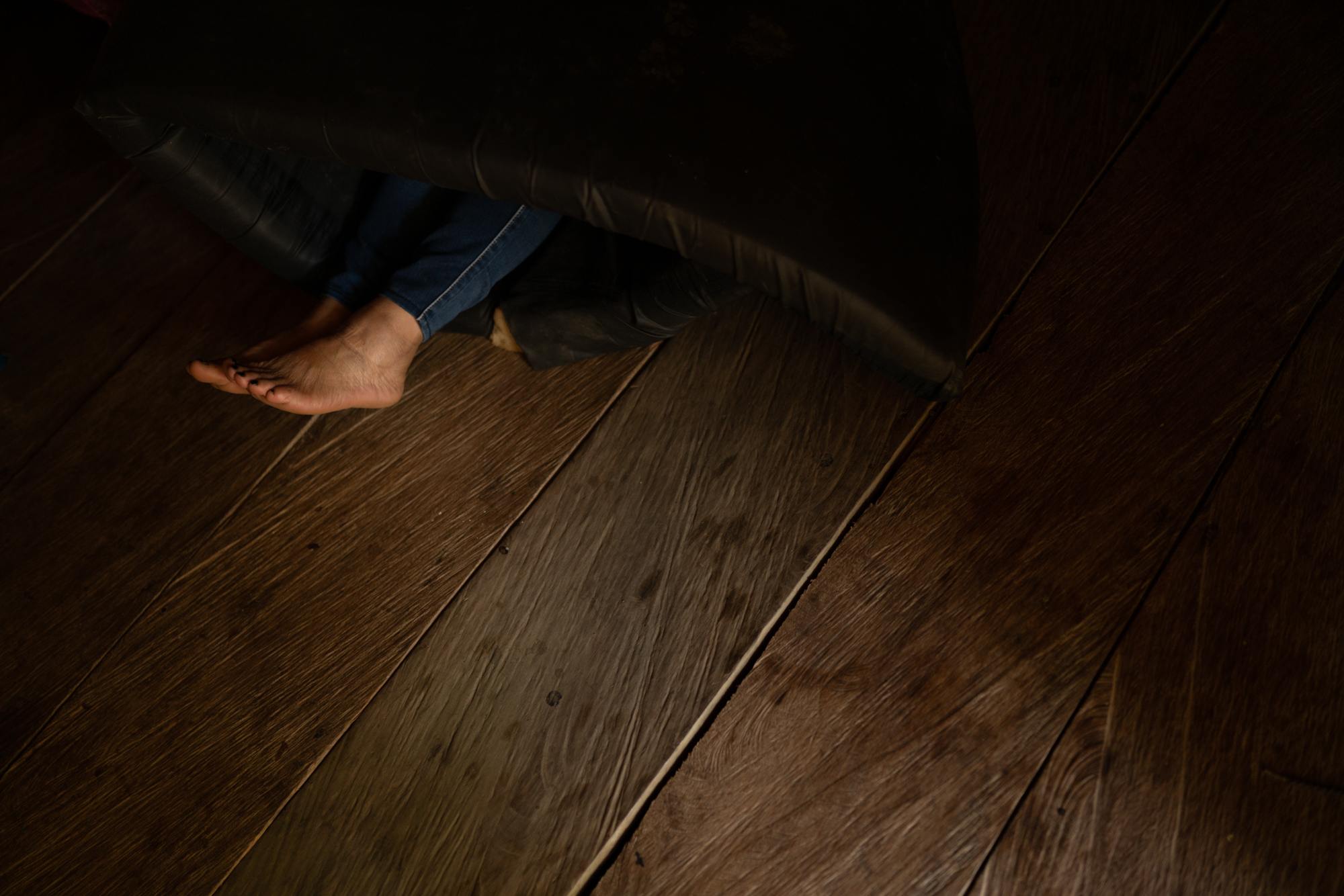
In 2004 the government fumigated coca crops from the Vereda la Reforma, these farms are in natural park’s area, when they came to fumigate, the helicopters fired and the planes dropped bombs, she got under the bed and put on a mattress above together with her young daughter. By Andrés Cardona.
We wanted to reconstruct history in three generations. And for example, there is a girl, Danna Valentina, who says that when the army arrives she cannot go to school, because the army closes the two roads on the sidewalks and also because she is at risk.
When the army arrives, there is eradication. When the Illicit Crop Substitution Plan (Plan de sustitución de cultivos ilícitos PNIS) was created, these people could not benefit from the plan, they could not substitute because they are in an area of environmental protection. And there is supposed to be nothing there.
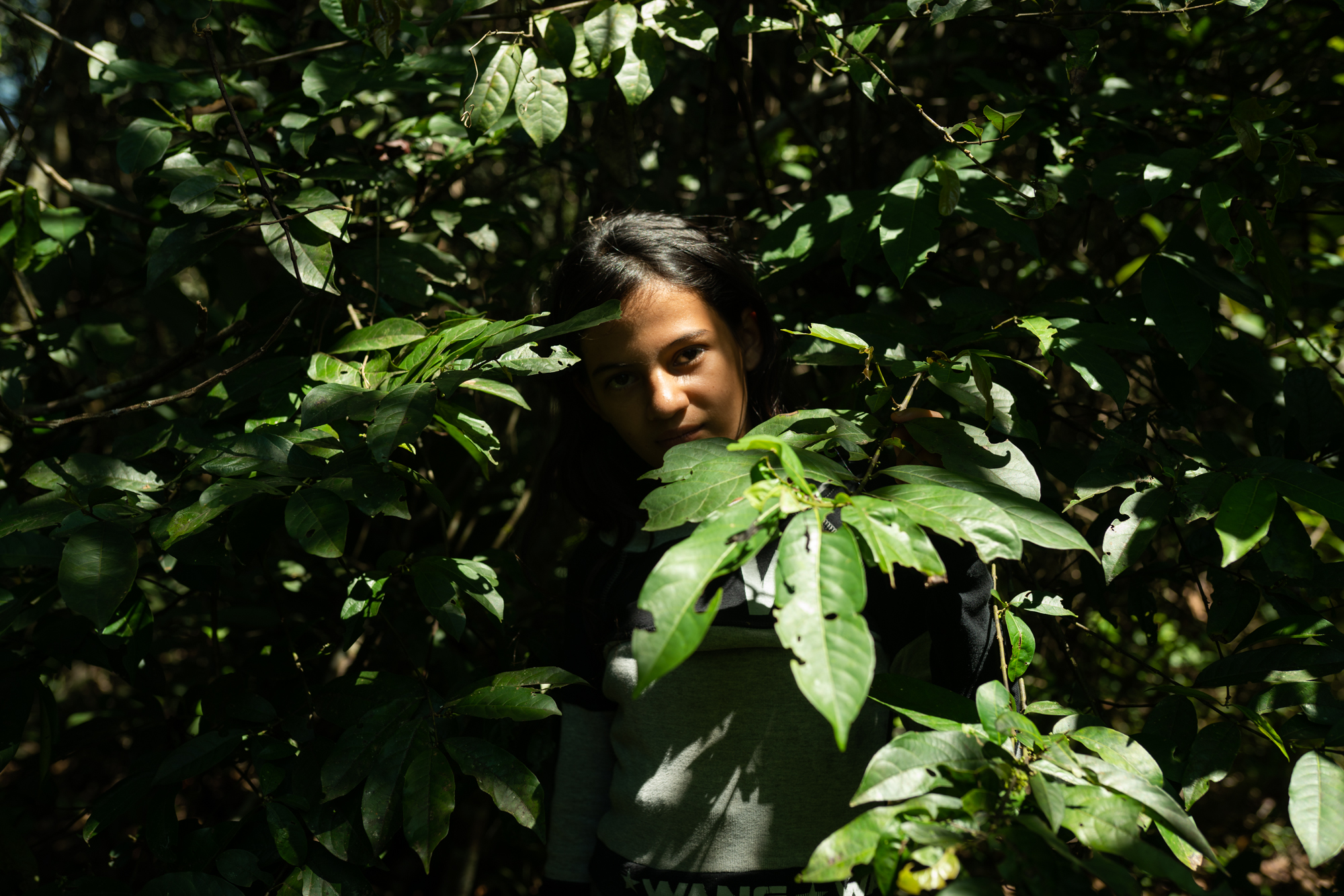
Danna Valentina Patarroyo Hernández is 13 years old and lives in the Caño Cabra village, when the Army is in Guayabero, she does not go to school for fear that something will happen to her on the way. By Andrés Cardona.
A lot of people repeat that idea about the absence of the state in certain areas. But at the same time it is present with the existence of the National Natural Park, the existence of the environmental authorities or even the presence of the Armed Forces. They are all forms of the presence of the state, right? What do you mean by state absence in this case?
I mean that these communities, for example, have to build their own schools. Because there is no health post, therefore they have to go to a city and spend a fortune because they are in the jungle, to be checked by a doctor who will prescribe two acetaminophen pills. I mean they have no roads.
When I say presence of the state, above all I speak of infrastructure, in every sense the investment is not reaching there. There is no statal money in that area, there is no education, there is no health or it just seems that this was a different state. There the state do not invest, do not create companies, do not build a road. It just seems that for the state these people do not exist.
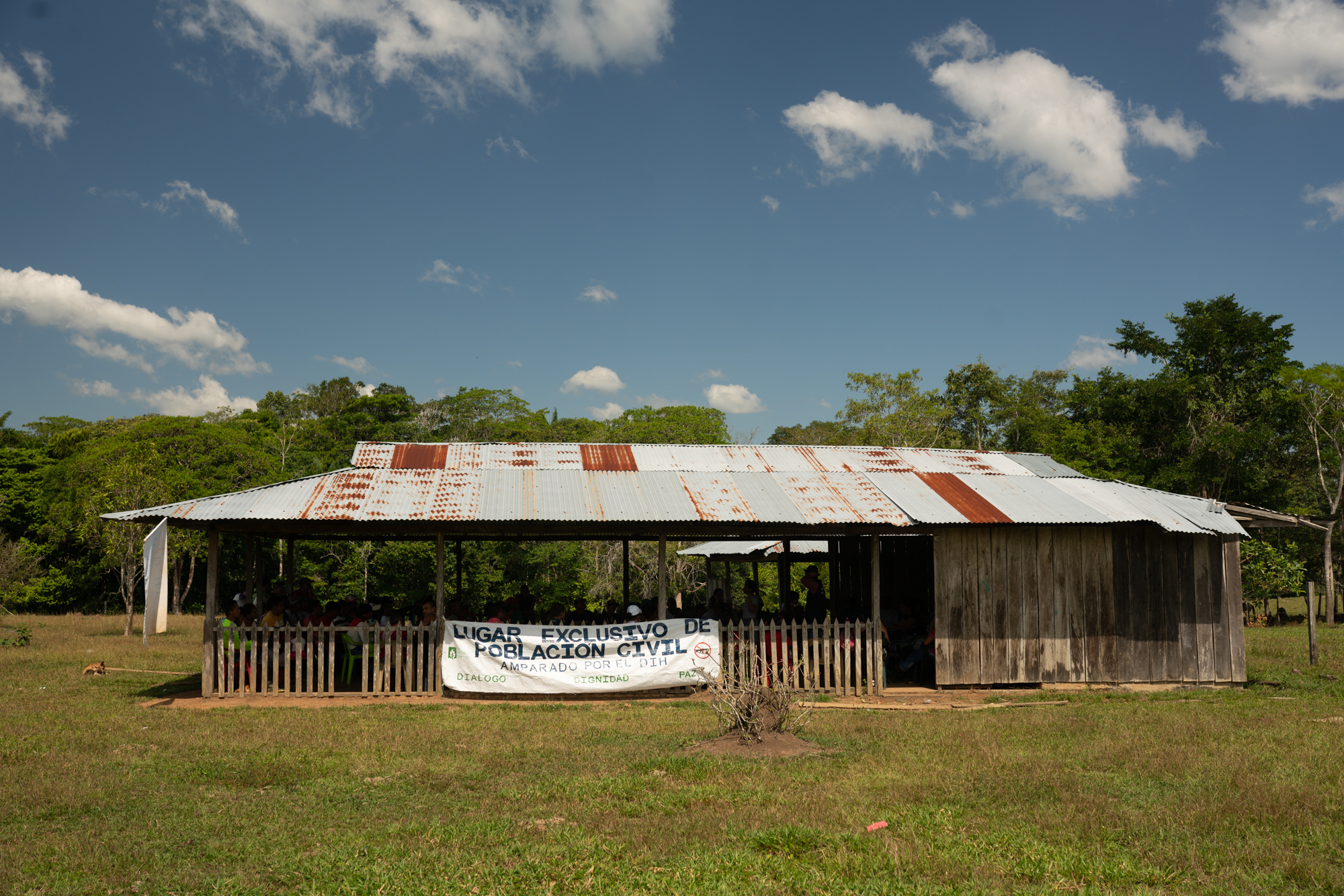
Community meeting in the Caño Cabra village. By Andrés Cardona.
In political terms, it is the same. There is no figure that function, for example, judicially and can solve this type of problem in the area. Who did that? Well, the guerrilla that assumed the justice before. And that also means that the State was not present to take on those things.
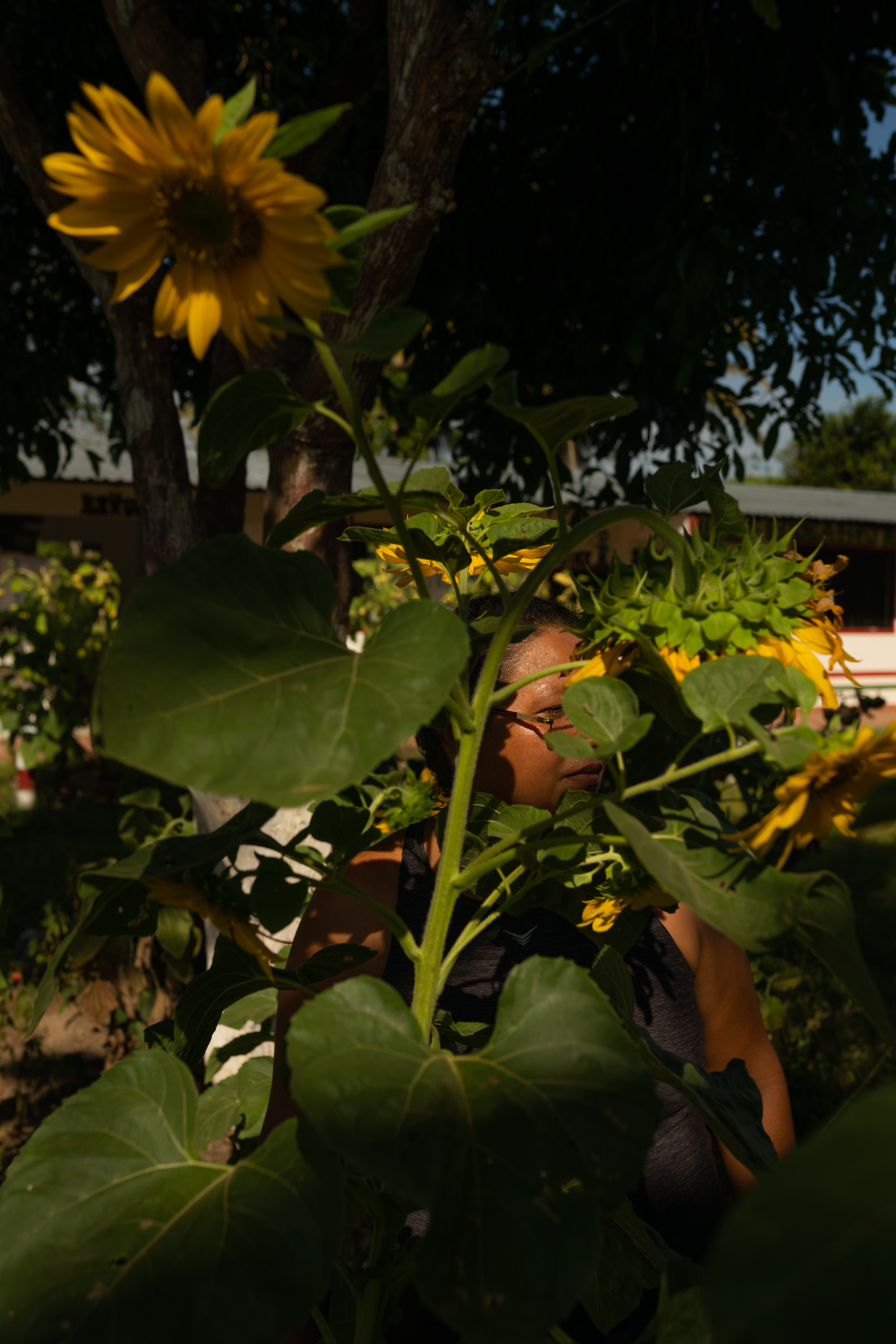
María Manrique, 42, is in charge of providing first aid to the community, in this area there is no health service. By Andrés Cardona.
In Coca coin, how inflated are the prices compared to other places in Colombia?
Normally in a town a beer costs $ 2000 pesos there it cost $3000. But, the pound of meat is produced there. If you buy it in Bogotá, it is meat that comes from Caquetá and Guaviare, it costs much more. There are things that are high. For example, transportation is very expensive, moving in the area is very expensive because it is by river and fuel is expensive. Commodities generally go up a bit, but they are somewhat regulated. Still I think they are still expensive for the region. But of course, these products travel in cars, then in boats, then in mules to the community.
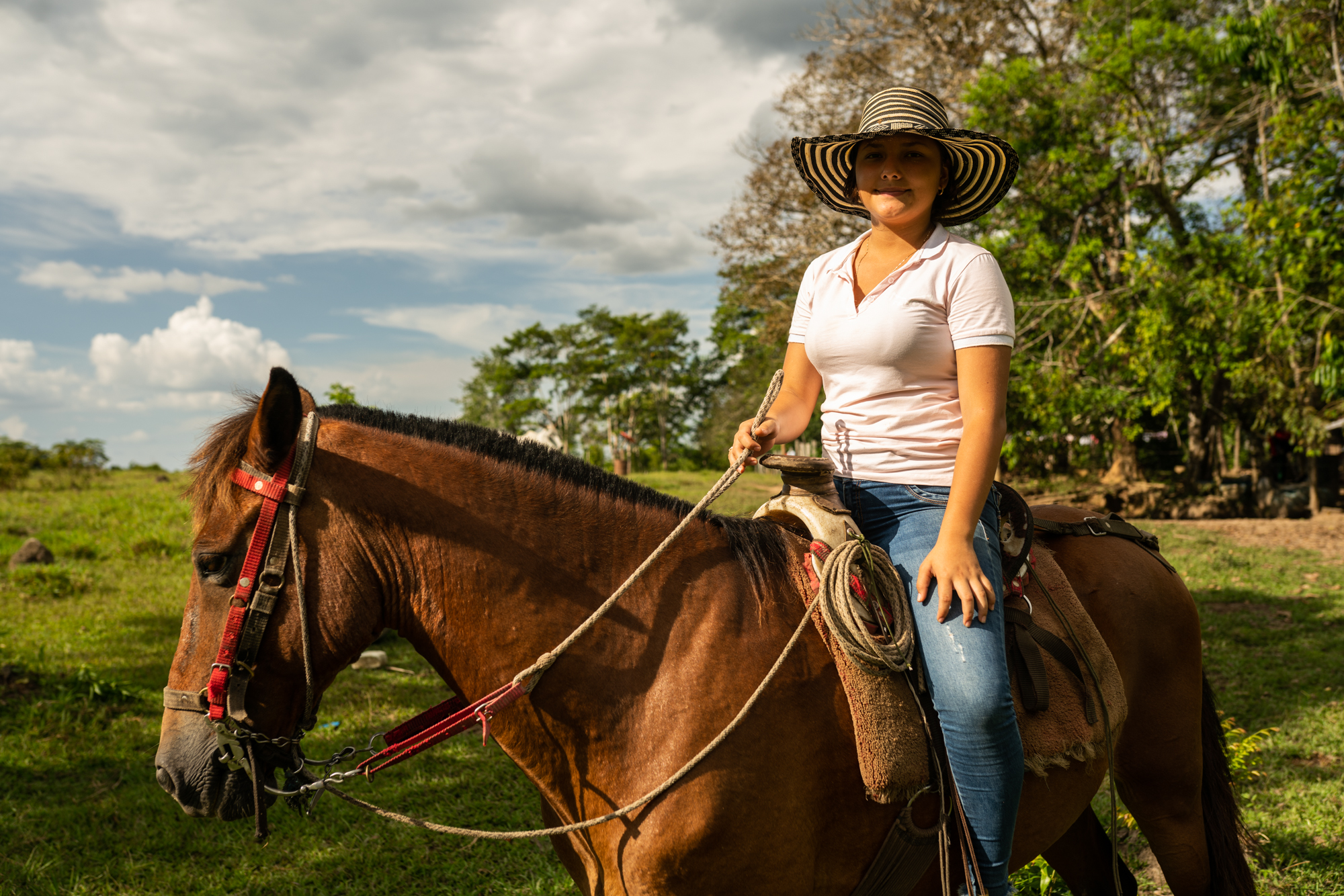
Faisiury Gonzales Morales is 14 years old, she was born on March 6, 2007, a day after her family was displaced from the farm by the military presence. By Andrés Cardona.

